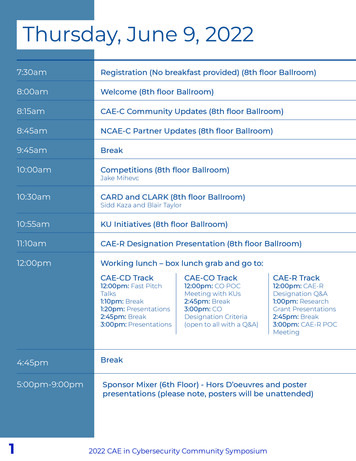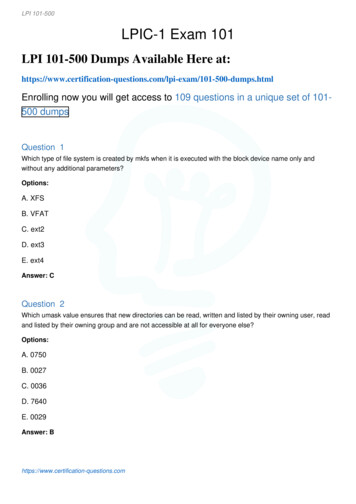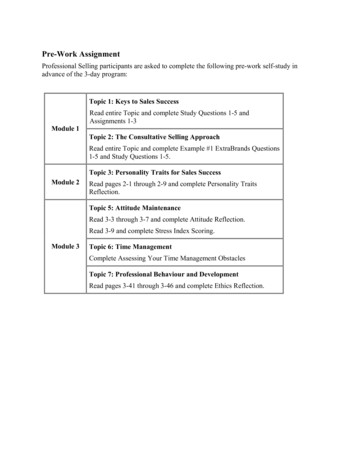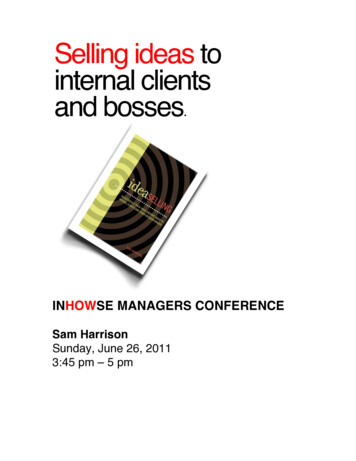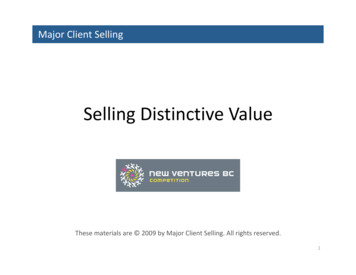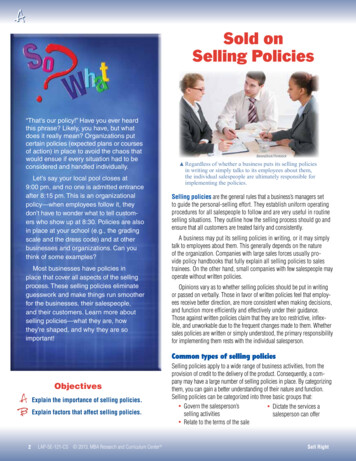
Transcription
David Jobber Geoff LancasterSelling and Sales ManagementOver the last twenty years, Selling and Sales Management has proved itself to be thedefinitive text in this exciting and fast-moving area. The new edition comes fully updatedwith brand new case studies using working businesses to connect sales theory to thepractical implications of selling in a modern environment.New to this edition: Integration of recent cutting-edge research throughout the book. Fully updated coverage of technological applications in selling and salesmanagement. A more detailed coverage of ethics in selling and sales management. Expanded coverage of sales training and organisation. A more in-depth look at the sales cycle, cold canvassing and systems selling. A more thorough coverage of B2B and B2C selling. Additional exercises to assist both students and tutors.About the authorsDavid Jobber is Professor of Marketing at Bradford University and serves on theeditorial board of numerous marketing and sales management journals. He alsoserved as Special Advisor to the Research Assessment Exercise panel that ratedresearch output from business and management schools throughout the UK.David Jobber has also received the Academy of Marketing Life achievementaward for extraordinary and distinguished services to marketing.8theditionDon’t forget to visit www.pearsoned.co.uk/jobber for additional learning resources.David Jobber Geoff LancasterSelling andSales Management8th editionCover image Getty ImagesCVR JOBB0652 08 SE CVR.indd 1www.pearson-books.comJobber LancasterGeoff Lancaster is Dean of Academic Studies at London School of Commerce andChairman of Durham Associates Group Ltd. He was formerly Research Professorof Marketing at London Metropolitan University, Senior Examiner to the CharteredInstitute of Marketing and Chief Examiner to the Institute of Sales and MarketingManagement.An imprint ofSelling and Sales Management8th edition9/2/09 15:55:40
A01 JOBB0652 08 SE FM.QXD3/3/0911:59 AMPage iSelling and Sales Management
A01 JOBB0652 08 SE FM.QXD3/3/0912:00 PMPage iiWe work with leading authors to develop thestrongest educational materials in businessand marketing, bringing cutting-edge thinkingand best learning practice to a global market.Under a range of well-known imprints, includingFinancial Times Prentice Hall, we craft high-qualityprint and electronic publications that help readersto understand and apply their content, whetherstudying or at work.To find out more about the complete range of ourpublishing, please visit us on the World Wide Web at:www.pearsoned.co.uk
A01 JOBB0652 08 SE FM.QXD3/3/0912:00 PMPage iiiSelling and SalesManagement8th editionDavid JobberUniversity of BradfordGeoffrey LancasterLondon School of Commerce
A01 JOBB0652 08 SE FM.QXD3/3/0912:00 PMPage ivPearson Education LimitedEdinburgh GateHarlowEssex CM20 2JEEnglandand Associated Companies throughout the worldVisit us on the World Wide Web at:www.pearsoned.co.ukFirst published as Sales Technique and Management by Macdonald and Evans Ltd in 1985Second edition published by Pitman Publishing, a division of the Longman Group UK Ltd in 1990Third edition published by Pitman Publishing, a division of the Longman Group UK Ltd in 1994Fourth edition published by Pitman Publishing, a division of Pearson Professional Ltd in 1997Fifth edition published by Financial Times Management, a division of Financial Times Professional Limited in 1990Sixth edition published in 2003Seventh edition published in 2006Eighth edition published in 2009 Macdonald and Evans Ltd 1985 David Jobber and Geoff Lancaster 1990 Longman Group UK Ltd 1994 Pearson Professional Ltd 1997 Financial Times Professional Ltd 2000 Pearson Education Limited 2003, 2006, 2009The rights of David Jobber and Geoff Lancaster to be identified as authors of this work have been asserted by them inaccordance with the Copyright, Designs and Patents Act 1988.All rights reserved. No part of this publication may be reproduced, stored in a retrieval system, or transmitted in anyform or by any means, electronic, mechanical, photocopying, recording or otherwise, without either the prior writtenpermission of the publisher or a licence permitting restricted copying in the United Kingdom issued by the CopyrightLicensing Agency Ltd, Saffron House, 6–10 Kirby Street, London EC1N 8TS.All trademarks used herein are the property of their respective owners. The use of any trademark in this text does notvest in the author or publisher any trademark ownership rights in such trademarks, nor does the use of such trademarksimply any affiliation with or endorsement of this book by such owners.ISBN: 978-0-273-72065-2British Library Cataloguing-in-Publication DataA catalogue record for this book is available from the British LibraryLibrary of Congress Cataloging-in-Publication DataJobber, David, 1947–Selling and sales management / David Jobber, Geoffrey Lancaster. — 8th ed.p. cm.ISBN 978-0-273-72065-2 (pbk.)1. Selling. 2. Sales management. I. Lancaster, Geoffrey, 1938- II. Title.HF5438.25.J63 2009658.8'1—dc22200900292510 9 8 7 6 5 4 3 2 113 12 11 10 09Typeset in 10/12.5 pt Palatino by 73Printed by Ashford Colour Press Ltd, GosportThe publisher’s policy is to use paper manufactured from sustainable forests.
A01 JOBB0652 08 SE FM.QXD3/3/0912:00 PMPage vBrief contentsPart one Sales perspective1 Development and role of selling in marketing2 Sales strategiesPart two Sales environment3 Consumer and organisational buyer behaviour134575774 Sales settings1115 International selling1566 Law and ethical issues200Part three Sales technique2237 Sales responsibilities and preparation2258 Personal selling skills2479 Key account management28110 Relationship selling30711 Direct marketing33012 Internet and IT applications in selling and salesmanagement352Part four Sales management38113 Recruitment and selection38314 Motivation and training40415 Organisation and control436
A01 JOBB0652 08 SE FM.QXDvi3/3/0912:00 PMPage viBrief contentsPart five Sales control16 Sales forecasting and budgeting45717 Salesforce evaluation493Appendix: Cases and discussion questions511Index535459Supporting resourcesVisit www.pearsoned.co.uk/jobber to find valuable online resourcesFor instructors A fully updated Instructors Manual, including suggested teachingapproaches and sample answers to questions in book. Media-Rich PowerPoint slides which are downloadable and available to usefor teaching.For more information please contact your local Pearson Education salesrepresentative or visit www.pearsoned.co.uk/jobber
A01 JOBB0652 08 SE FM.QXD3/3/0912:00 PMPage viiContentsList of figuresxivList of tablesxviAbout the authorsxviiiPrefacexixAcknowledgementsxxiPart one Sales perspective1 Development and role of selling in marketingObjectivesKey concepts1.1 Background1.2 The nature and role of selling1.3 Characteristics of modern selling1.4 Success factors for professional salespeople1.5 Types of selling1.6 Image of selling1.7 The nature and role of sales management1.8 The marketing concept1.9 Implementing the marketing concept1.10 The relationship between sales and marketing1.11 ConclusionsReferencesPractical exercise: Mephisto Products LtdExamination questions2 Sales strategiesObjectivesKey concepts2.1 Sales and marketing planning13334457812141518364041424445454546
A01 JOBB0652 08 SE FM.QXDviii3/3/0912:00 PMPage viiiContents2.2 The planning process2.3 Establishing marketing plans2.4 The place of selling in the marketing plan2.5 ConclusionsReferencesPractical exercise: Auckland Engineering plcExamination questionsPart two Sales environment3 Consumer and organisational buyer behaviourObjectivesKey concepts3.1 Differences between consumer and organisational buying3.2 Consumer buyer behaviour3.3 Factors affecting the consumer decision-making process3.4 Organisational buyer behaviour3.5 Factors affecting organisational buyer behaviour3.6 Developments in purchasing practice3.7 Relationship management3.8 ConclusionsReferencesPractical exercise: The lost computer saleExamination questions4 Sales settingsObjectivesKey concepts4.1 Environmental and managerial forces thatimpact on sales4.2 Sales channels4.3 Industrial/commercial/public authority selling4.4 Selling for resale4.5 Selling services4.6 Sales promotions4.7 Exhibitions4.8 Public relations4.9 ConclusionsReferencesPractical exercise: Yee Wo Plastic Piping Components LtdPractical exercise: Gardnov LtdPractical exercise: Quality Chilled Foods LtdExamination 1152154155
A01 JOBB0652 08 SE FM.QXD3/3/0912:00 PMPage ixContents5 International sellingObjectivesKey concepts5.1 Introduction5.2 Economic aspects5.3 International selling at company level5.4 Cultural factors in international selling5.5 Organisation for international selling5.6 Pricing5.7 Japan – a study in international selling5.8 ConclusionsReferencesPractical exercise: Selling in ChinaPractical exercise: SyplanPractical exercise: Wardley Investment Services (Hong Kong)Practical exercise: Quality Kraft Carpets LtdExamination questions6 Law and ethical issuesObjectivesKey concepts6.1 The contract6.2 Terms and conditions6.3 Terms of trade6.4 Business practices and legal controls6.5 Ethical issues6.6 ConclusionsReferencesPractical exercise: Kwiksell Cars LtdPractical exercise: ChevronTexaco cuts losses with Innovetra Fraud AlerterExamination questionsPart three Sales technique7 Sales responsibilities and preparationObjectivesKey concepts7.1 Sales responsibilities7.2 Preparation7.3 ConclusionsReferencesPractical exercise: The O’Brien 23225225225226235243243244
A01 JOBB0652 08 SE FM.QXDx3/5/092:56 PMPage xContentsPractical exercise: Presenting New Standa Plus:The final word in hydraulic braking systems?Examination questions8 Personal selling skillsObjectivesKey concepts8.1 Introduction8.2 The opening8.3 Need and problem identification8.4 The presentation and demonstration8.5 Dealing with objections8.6 Negotiation8.7 Closing the sale8.8 Follow-up8.9 ConclusionsReferencesPractical exercise: Mordex Photocopier CompanyNegotiation exercise: Supermarket versus superbrand:co-operate to competePractical exercise: A controlled sales process?Examination questions9 Key account managementObjectivesKey concepts9.1 What is key account management?9.2 Advantages and dangers of key account management to sellers9.3 Advantages and dangers of key account management to customers9.4 Deciding whether to use key account management9.5 Criteria for selecting key accounts9.6 The tasks and skills of key account management9.7 Key account management relational development model9.8 Global account management9.9 Building relationships with key accounts9.10 Key account information and planning system9.11 Key success factors for key account management9.12 ConclusionsReferencesPractical exercise: Cloverleaf plcExamination questions10 Relationship sellingObjectivesKey 4296299300300303306307307307
A01 JOBB0652 08 SE FM.QXD3/5/092:56 PMPage xiContents10.1 From total quality management to customer care10.2 From JIT to relationship marketing10.3 Reverse marketing10.4 From relationship marketing to relationship selling10.5 Tactics of relationship selling10.6 ConclusionsReferencesPractical exercise: MicrocomPractical exercise: Focus Wickes – ‘Fusion’:Winners, 2004 Retail Week Supply Chain Initiative AwardExamination questions11 Direct marketingObjectivesKey concepts11.1 What is direct marketing?11.2 Database marketing11.3 Managing a direct marketing campaign11.4 ConclusionsReferencesPractical exercise: Kettle FoodsPractical exercise: RU receiving me?Examination questions12 Internet and IT applications in selling and salesmanagementObjectivesKey concepts12.1 The changing nature of the salesforce12.2 Electronic commerce and electronic procurement12.3 Using technology to support sales activities12.4 Using technology to improve sales management12.5 ConclusionsReferencesPractical exercise: RaytheonExamination 7379380Part four Sales management38113 Recruitment and selection383ObjectivesKey concepts13.1 The importance of selection13.2 Preparation of the job description andspecification383383384387
A01 JOBB0652 08 SE FM.QXDxii3/5/092:56 PMPage xiiContents13.3 Identification of sources of recruitment and methodsof communication13.4 Designing an effective application form andpreparing a shortlist13.5 The interview13.6 Supplementary selection aids13.7 ConclusionsReferencesPractical exercise: Plastic Products LtdExamination questions14 Motivation and trainingObjectivesKey concepts14.1 Motivation14.2 Leadership14.3 Training14.4 ConclusionsReferencesPractical exercise: Selling fountain pensExamination questions15 Organisation and compensationObjectivesKey concepts15.1 Organisational structure15.2 Determining the number of salespeople15.3 Establishing sales territories15.4 Compensation15.5 ConclusionsReferencesPractical exercise: RovertronicsPractical exercise: Silverton Confectionery CompanyExamination art five Sales control45716 Sales forecasting and budgeting459ObjectivesKey concepts16.1 Purpose16.2 Planning16.3 Levels of forecasting459459460460463
A01 JOBB0652 08 SE FM.QXD3/5/092:56 PMPage xiiiContents16.4 Qualitative techniques16.5 Quantitative techniques16.6 Budgeting – purposes16.7 Budget determination16.8 The sales budget16.9 Budget allocation16.10 ConclusionsReferencesPractical exercise: Classical Reproductions LtdPractical exercise: A recipe for successExamination questions17 Salesforce ObjectivesKey concepts17.1 The salesforce evaluation process17.2 The purpose of evaluation17.3 Setting standards of performance17.4 Gathering information17.5 Measures of performance17.6 Appraisal interviewing17.7 ConclusionsReferencesPractical exercise: Dynasty LtdPractical exercise: MacLaren Tyres LtdExamination pendix: Cases and discussion questions511Beiersdorf and Nivea: Researching and understandingthe market and customersHutchinson Whampoa: Market leadershipin the 3G marketMcCain: Responding to changes in the external environmentSyngenta: Developing products for a better worldIndex511518524530535
A01 JOBB0652 08 SE FM.QXD3/3/0912:00 PMPage xivList of 8.38.4Characteristics of modern sellingTypes of sellingSales versus market orientationThe product life-cycle curveThe adoption of innovationsThe demand curveA simple break-even chartOrganisational implications of adopting the marketing conceptMarketing strategy and management of personal sellingThe planning processHierarchy of the marketing planSWOT matrix for a sports car producerAn overview of the marketing planning processInside-out planning modelOutside-in planning modelStages in the buying processThe relationship between objectives, strategies and tacticsThe consumer decision-making processThe evaluation systemLevel of purchase involvement and the buying situationDimensional model of buyer behaviourThe organisational decision-making process (buy phases)Influences on organisational purchasing behaviourReverse marketingA model of the exhibition communication processPrahalad and Doz integration and responsiveness modelExample of conditions of sale documentKey responsibilities of salespeopleA negotiating scenarioThe personal selling processDealing with objectionsThe level of buyers’ purchase intentions throughout a sales presentationClosing the 4140167203226242250261268269
A01 JOBB0652 08 SE FM.QXD3/3/0912:00 PMPage xvList of 6.316.416.516.616.717.117.217.3Traditional (bow-tie) buyer–seller relationship: communication isbetween salesperson and buyerKey account (diamond) based relationship: key account managerco-ordinates communication which is direct between functionsKey account relational development modelKey account planning systemInternal to external focus of total quality perspectiveMarketing information systemExpenditure on direct marketing in EuropeManaging a direct marketing campaignFour levels of e-commerceStages in the recruitment and selection processImportant qualities of salespeopleHow companies attract external applicantsThe Vroom expectancy theory of motivationMethods of conducting sales meetingsSalesforce motivationMotivating factors for salespeopleSummary of differences between sales directors and salesrepresentativesComponents of a training programmeCriteria used to evaluate training coursesFountain pen featuresOrganisation structuresCompensation and sales volumeA conceptually based model of judgemental forecastingOffice Goods Supplies Ltd: annual sales of briefcases,moving averageOffice Goods Supplies Ltd: annual sales of briefcases,exponential smoothingOffice Goods Supplies Ltd: quarterly sales of briefcasesand one-year forecastOffice Goods Supplies Ltd: monthly sales of briefcases,Z chart for 2008The budgetary processDecision tree for Classical Reproductions LtdThe salesforce evaluation processThe central role of evaluation in sales managementSalesperson evaluation 5503
A01 JOBB0652 08 SE FM.QXD3/3/0912:00 PMPage xviList of 14.814.915.1Strengths and weakness of personal sellingThe top ten success factors in sellingMarketing strategy and sales managementSocial class categoriesChoice criteriaForces affecting selling and sales managementCharacteristics of services and productsTop ten criteria used by sales agents to evaluate principalsTranslations of common Japanese business titlesProduct features and customer benefitsKey characteristics of salespeople desired by buyersTypes of question used in personal sellingDistinctions between transactional selling and key account managementTasks performed and skills required by key account managementRoles and competencies required of a global account managerHandling relationships with key accountsA key account information systemKAM key success factorsWell-known US sales force automation (SFA) software packagesFeatures of most interest and most valueQualities required of trainee and senior sales executivesMaslow’s hierarchy of needsMotivational factors for salespeople in industrial and consumergoods marketsTopics salespeople would like to discuss more with theirsales managersPositive and negative strokesSix leadership styles and key characteristicsBenefits of trainingSkills developmentMethods used to train sales managersTopics covered in sales training programmesStrengths and weaknesses of geographic and product specialisationin organisational 5297299368385388406412414415418420422429429439
A01 JOBB0652 08 SE FM.QXD3/3/0912:00 PMPage xviiList of 17.4Strengths and weaknesses of customer-based organisational structuresWorkload methodThe use of compensation methods in the United KingdomOffice Goods Supplies Ltd: Annual sales of briefcases, moving averageOffice Goods Supplies Ltd: Quarterly sales of briefcasesOffice Goods Supplies Ltd: Sum of quarterly deviations from trendOffice Goods Supplies: Forecasted trend figures and deviationsfrom trend that have been appliedOffice Goods Supplies Ltd: Monthly sales of briefcases 2007–08A comparison of the usage of salesforce evaluation outputcriteria between small and large organisationsA comparison of the usage of salesforce evaluation inputcriteria between small and large organisationsA comparison of the usage of qualitative salesforce evaluation criteriabetween small and large organisationsWinning and losing ordersxvii442446451469472473473475500501502504
A01 JOBB0652 08 SE FM.QXD3/3/0912:00 PMPage xviiiAbout the authorsDavid Jobber BA (Econ), MSc, PhD is an internationally recognised marketing academic and is Professor of Marketing at the University of Bradford School of Management. Before joining the faculty at the School of Management, he worked in sales andmarketing for the TI Group and was Senior Lecturer in Marketing at HuddersfieldUniversity. He has wide experience of teaching sales and marketing at undergraduate, postgraduate and executive levels and has held visiting appointments at the universities of Aston, Lancaster, Loughborough and Warwick. Supporting his teachingis a record of achievement in academic research and scholarship. David has published four books and over 100 research papers in such internationally-rated journalsas the International Journal of Research in Marketing, the Journal of Personal Selling andSales Management, and the Strategic Management Journal. His eminence in researchwas recognised by his appointment as Special Adviser to the Research AssessmentExercise panel. In 2008, David received the Academy of Marketing Life Achievementaward for extraordinary and distinguished services to marketing.Geoff Lancaster MSc, PhD, FCIM, FLCC, MCMI, MCIPS is Dean of Academic Studies at the London School of Commerce, a constituent college of University of WalesInstitute Cardiff. He is Chairman of a corporate communications company DurhamAssociates Group Ltd, Castle Eden, County Durham with offices in London, Hull,Bahrain and Oman. The company is in receipt of the Queen’s Award for ExportAchievement. He was formerly Professor of Marketing at Huddersfield Universityand held appointments at the University of Newcastle-upon-Tyne, London Metropolitan University and Macquarie University, Sydney. He was previously SeniorExaminer and Senior Academic Adviser to the Chartered Institute of Marketingand Chief Examiner to the Institute of Sales and Marketing Management. He haspublished marketing and research methods textbooks with McGraw-Hill, Macmillan,Butterworth-Heinemann and Kogan-Page. Geoff has published widely in academicmarketing journals such as European Journal of Marketing, Journal of Advertising Researchand Journal of Marketing Management.
A01 JOBB0652 08 SE FM.QXD3/3/0912:00 PMPage xixPrefacePREMISEThis text covers what must still be the most important element of the marketing mixfor most students and practitioners. With a move away from the selling function towards more esoteric areas of marketing over the past few years, this vital aspect ofmarketing has been somewhat neglected. However, in the end it has to be face-toface contact that eventually wins the order, and this text therefore explains and documents the selling and sales management process from both the theoretical andpractical viewpoints.BOOK STRUCTUREMore precisely, the text is split into five logical parts: Sales Perspective, Sales Environment, Sales Technique, Sales Management and Sales Control.Sales Perspective examines selling in its historical role and then views its placewithin marketing and a marketing organisation. Different types of buyers are alsoanalysed in order to help us achieve an understanding of their thinking and organiseour selling effort accordingly. Sales Technique is essentially practical and coverspreparation for selling, the personal selling process and sales responsibility. SalesEnvironment looks at the institutions through which sales are made; this coverschannels, including industrial, commercial and public authority selling followed byselling for resale. International selling is an increasingly important area in view of theever increasing ‘internationalisation’ of business and this merits a separate chapter.Sales Management covers recruitment, selection, motivation and training, in addition to how we must organise and compensate salespeople from a managerial standpoint. Finally, Sales Control covers sales budgets and explains how this is thestarting point for business planning. Sales forecasting is also covered in this final section, and a guide is given to the techniques of forecasting and why it is strictly a responsibility of sales management and not finance. Each chapter concludes with amini-case study and practical exercises, together with formal practice questions typical of those the student will encounter in the examination room.
A01 JOBB0652 08 SE FM.QXDxx3/3/0912:00 PMPage xxPrefaceNEW TO THIS EDITIONThe eighth edition provides an integration of recent cutting edge selling and salesmanagement research into chapters throughout the book. Also, the Internet and ITapplications in selling and sales management chapter has been substantially revised toreflect recent advances, and technological applications in selling integrated into relevant chapters in the book. We wish to thank, John O’Connor, chief executive, DeepInsight, for his work on this chapter. More coverage of ethics in selling and salesmanagement, systems purchasing and selling, sales training, sales force organization, B2B and B2C selling and the sales cycle is provided in this edition. This eighthedition also includes new cases featuring major companies. As always, this editioncontinues to place emphasis on international aspects of selling and sales management to reflect the importance of international markets in today’s global economy. Inparticular, a new case focusing on selling to China has been written.TARGET MARKETThis text will be invaluable to those students studying for the examinations of theChartered Institute of Marketing, the Communication, Advertising and MarketingEducation Foundation, the London Chamber of Commerce and Industry higherstage selling and sales management subject, marketing specialisms on Higher NationalCertificate and Diploma in Business Studies, first degrees with a marketing input,and postgraduate courses like the Diploma in Management Studies and Master ofBusiness Administration that have a marketing input. In addition, the text emphasises the practical as well as the theoretical, and it will be of invaluable assistance tosalespeople in the field as well as to sales management.ACKNOWLEDGEMENTSWe would like to thank Richard Cork, Belinda Dewsnap, Martin Evans, Jason Greenaway, Diana Luck, Paul Miller and John O’Connor for providing excellent materialon the applications of IT in sales. We also wish to thank all of the case contributors forsupplying excellent case studies to enhance the practical aspects of the book. We alsothank the reviewers who provided feedback for this edition.Finally, we would like to thank our editorial team at Pearson Education, especiallyDavid Cox, for helping make this new edition possible.
A01 JOBB0652 08 SE FM.QXD3/4/094:15 PMPage xxiAcknowledgementsWe are grateful to the following for permission to reproduce copyright material:Table 1.2 from Marshall, G.W., Goebel, D.J. & Moncrief, W.C. (2003) Hiring for successat the buyer-seller interface in Journal of Business Research, 56, pp. 247–55. Copyright 2003 with permission from Elsevier; Figure 1.1 from Moncrief, W.C. & Marshall, G.W.(2005) The evolution of the seven steps of selling in Industrial Marketing Management,34, pp. 13–22. Copyright 2005 with permission from Elsevier; Table 3.1 from Socialclass categories in National Readership Survey, January–December 2007; Table 5.1 Top 10criteria used by sales agents to evaluate principles, reprinted from Merritt, N.J. &Newell, S.J. (2001) The extent and formality of sales agency evaluations of principalsin Industrial Marketing Management, 30, pp. 37–49. Copyright 2001 with permissionfrom Elsevier; Table 8.1 from Williams, A.J. & Seminerio, J. (1985) What buyers likefrom salesmen in Industrial Marketing Management, 14, pp. 75–8; Figures 9.1 and 9.2from Shipley, D. & Palmer, R. (1997) Selling to and managing key accounts in The CIMHandbook of Selling and Sales Strategy, Butterworth-Heinemann, Oxford, p. 95. Copyright 1997 reprinted with permission from Elsevier; Table 9.6 from Abratt, R. &Kelly, P.M. (2002) Customer-supplier partnerships: perceptions of a successful key account management program in Industrial Marketing Management, 31, pp. 467–76.Copyright 2002 with permission from Elsevier; Figure 11.1 adapted from Directmarketing expenditure and Direct marketing expenditure per capita in EuropeanMarket Pocket Book 2005. Copyright 2005, reprinted by permission of the WorldAdvertising Research Centre; Table 13.2 from Mathews, B. & Redman, T. (2001) Recruiting the wrong salespeople: are the job ads to blame? in Industrial Marketing Management, 30, pp. 541–50; Table 14.5 from Goleman, D. (2000) Leadership that gets resultsin Harvard Business Review, March–April 2000, pp. 78–80.Pages 259–60 adapted from www.chapmanHQ.com; page 312, excerpt from the casestudy ‘Action Mobile Industries . . .’ courtesy of the Chapman Group, www.chapmanhq.com. Reprinted with permission; page 316, adapted from an article thatfirst appeared in Supply Management, (Parker, M., 18 July 2002); pp. 334–5 fromMitchell, A. (2002) Consumer power on the cards in Tesco plan in Marketing Week; 2 May,pp. 30–1; pp. 511–16 ‘Beiersdorf and Nivea deodorant’ excerpt adapted from case studyfound at http://thetimes100.co.uk; pp. 518–23 ‘Hutchinson Whampoa: Market leadershipin the 3G market’ excerpt adapted from case study found at http://thetimes100.co.uk;pp. 524–9 ‘McCain – Responding to changes in the external environment’ excerptadapted from case study found at http://thetimes100.co.uk; pp. 530–4 ‘Syngenta
Selling and sales management / David Jobber, Geoffrey Lancaster. — 8th ed. p. cm. ISBN 978--273-72065-2 (pbk.) 1. Selling. 2. Sales management. I. Lancaster, Geoffrey, 1938- II. Title. HF5438.25.J63 2009 658.8'1—dc22 2009002925 10987654321 13 12 11 10 09 Typeset in 10/12.5 pt Palatino by 73 Printed by Ashford Colour Press Ltd, Gosport

